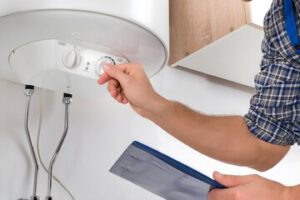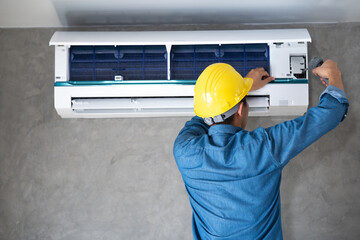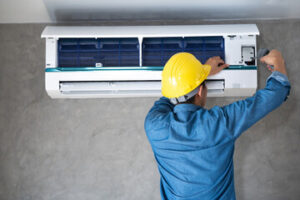Hooking up a new water heater requires a lot of moving parts. A licensed plumber can install your new water heater safely, according to local codes.

Working on an energized circuit can cause severe injury or death from electrical shock. Make sure the power is off before starting any work. Contact Water Heater Installation Denver for professional help.
The first step in installing a water heater involves collecting the necessary tools and materials. This includes the new water heater itself, as well as plumbing supplies and power tools such as a pipe wrench, pliers, copper tubing, Teflon tape, a voltage tester, a drill, and a hacksaw. It is also a good idea to have some steel wool on hand, as it can be used to clean up any excess debris that may be on the pipes before soldering them.
Before beginning any work, shut off the gas and water supply valves to the old hot water heater, and make sure that the water is fully drained from the existing pipes. This can help prevent scalding while you are working on the new installation, as well as helping to reduce the risk of accidental leaks around the new system.
Once the old water heater is disconnected, turn off the electricity to the unit. If there is a junction box cover on the hot water heater, remove it to expose the electrical wiring connections. Before connecting any wires, carefully read the printed installation instructions and safety warnings on the tank. You should also familiarize yourself with any local building codes or regulations that might apply to your particular installation.
You will need to connect the new water heater to the existing pipes. If you are using copper pipes, it’s a good idea to solder elbow joints onto one end of each pipe. This will help prevent leakages and allow you to connect the pipes securely, without needing to use a wrench. You should also consider installing insulation on the pipes, especially if they are located in an uninsulated area of your home.
When making the gas pipe connections, it is important to follow the manufacturer’s instructions and use a thread sealant designed for gas lines. It is also a good idea to install a sediment trap on the gas line going into the new water heater, as this can help protect the unit from mineral deposits. Once all of the connections are made, you can replace the junction box cover on the water heater.
Venting
A vent is a hole or passage through which smoke, gas or odors escape. A vent is also a way to express one’s feelings: She telephoned her best friend to vent about the latest happenings.
A new water heater needs a proper venting system to safely release combustion fumes and excess water out of the house. The venting requirements are different for gas and electric models. Gas models use natural or propane gas and rely on the building’s existing gas line to power the burner. Electric models use electricity to power the heater’s heating elements and depend on a dedicated circuit to run the pump. Depending on the model and your home’s current piping setup, the cost of installing a new gas or electric venting system may be $500 to $2,500.
The vent pipe must extend from the gas valve (Photo 6) to the outside and up through the roof. The vent should rise at least 12 in. before turning at the first elbow, and the pipe should be sloped to drain. To test the draft, close all doors and windows and move a lit match around the edge of the flue. If the flame flickers and fumes aren’t drawn up the vent pipe, the chimney is blocked or the ventilation system doesn’t work. Call a licensed plumber to fix the problem.
Many localities require that the venting system be changed from an atmospheric vent to a direct vent. In this system, a double-chambered pipe carries gases out of the house while fresh air is allowed in. It’s usually more expensive to install this system, and it can be challenging to do so in an existing home without modifying the structure’s plumbing.
After the venting is finished, turn off the gas at the valve near the water heater. Shut off the main water supply as well and drain the water by opening a faucet on the lowest floor. Next, connect the new temperature and pressure relief valve to the gas line by coating its threaded ends with pipe joint compound and screwing on the first nipple. Coat the remaining nipples with more compound and screw them on with pipe wrenches, then replace the vent hood.
Electrical
If the new water heater is an electric model, you need to have a professional electrician install a new circuit breaker and run a cable (2-pole, 30-amp breaker with 10-2NM cable) from the power source to the tank. This is typically done outside of the home and requires some carpentry work (if necessary). If your water heater uses gas, it will need a new natural or propane gas line to be run to the appliance. A professional plumber will need to make these connections as well.
If you have copper pipes that you need to cut for the water heater installation, clean them with sandpaper cloth and prepare them for soldering by applying a layer of pipe thread compound to each end. This will help ensure that the piping is properly sealed and will prevent leaks down the road. It’s also a good idea to have the professionals install a new hot water shut off valve at the water heater and a cold water shut off valve in your home, so you can easily turn off your water supply for maintenance without having to shut off your entire home.
Once the water lines are prepared, turn off the power to your water heater by turning off the circuit breaker that’s marked “water heater.” Turn off the gas if you have a gas-powered model and drain the old tank before removing it from the area.
Then, disconnect the electrical wires from the junction box at the top of the water heater by removing the plastic cover and insulation. Identify the black and white circuit wires by looking at their coloring or the label tags on the water heater. The white wire is the “hot” wire, while the black wire is the “neutral” wire. Connect the wires to each other using wire connectors and attach them to the grounding wire on the junction box. Use your label tag or a picture of how the wires were connected to help you remember where each one goes. Replace the junction box cover and insulation.
After the new water heater is in place, reconnect the wires by following your labels or the photos you took of the original connections. Connect the grounding wire to the green ground screw and replace the junction box cover. Once everything is in place, it’s time to turn the power back on and test your new water heater.
Installation
It’s important to work with a professional plumber on any water heater installation project. Not only can they ensure that your new system is installed correctly, but they can help you figure out which model and type of water heater is best for your home. This process involves figuring out how much hot water you use during peak times, so that you can choose an appropriately sized unit.
After removing the old water heater, make sure that the drainage pipe is connected to a drain pan. It’s also a good idea to install a new temperature and pressure relief valve on the drain line. This is an important safety feature, and it’s required by local plumbing codes.
Once the plumbing connections are made, you can connect the new water heater to the water lines and the electric power wires (if it’s an electric unit). Make sure that the drain valve is open and closed before switching on the water. It’s a good idea to install a manual shutoff valve before and after the heater as well. This will allow you to shut off the water supply to the heater for repairs or maintenance without having to shut off your whole house.
To make the connection, wrap the threads on two galvanized plastic-lined nipples with plumber’s tape and screw them onto the cold water inlet and hot water outlet openings on the top of the heater. Alternatively, you can prepare new pipe assemblies by cutting two lengths of copper pipe and soldering them together. To prevent the pipes from collapsing, you can use FIP adapters.
Before connecting the electrical cables, remove the cover from the electrical junction box on the top of the water heater and disconnect the wire connectors and cable clamp from the two power wires. You may need to use a cable cutter and tubing cutter to disconnect the pipes.
If the water heater is gas, you’ll need to disconnect the draft hood and cut the vent pipe from the top of the heater. You’ll also need to disconnect the gas control valve on the gas line by using a pipe wrench or channel-lock pliers.


